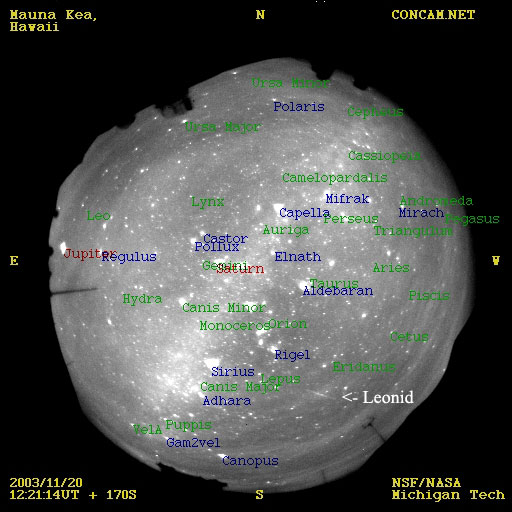Credit & Copyright: Mauna Kea CONCAM,
The Night Sky Live Project
Explanation:
The
2003 Leonids Meteor Shower contained relatively few meteors.
As expected and unlike the
last
few
years,
the Earth just did not pass through any dense
particle streams left over by the Sun-orbiting
Comet Tempel-Tuttle.
Preliminary reports had the peak
meteor rates only as high as about one relatively faint
meteor a minute even from good locations at good times.
Pictured above is one of the brighter
Leonids of 2003, caught by one of the continuously
operating night sky web cameras (CONCAMs) of the global
Night Sky Live project.
The
fisheye image shows the night sky from
horizon to horizon above
Mauna Kea,
Hawaii,
USA.
The image is annotated with several bright stars and planets.
Note that this meteor, as do all Leonids, appears to
emanate from the constellation Leo,
labeled on the upper left.
Although the peak of the
Leonids this year was on November 19,
this meteor flashed through the sky the next night.
1999 2000 2001 2002 2003 2004 2005 2006 2007 2008 2009 2010 2011 2012 2013 2014 2015 2016 2017 2018 2019 2020 2021 2022 2023 2024 2025 |
Январь Февраль Март Апрель Май Июнь Июль Август Сентябрь Октябрь Ноябрь Декабрь |
NASA Web Site Statements, Warnings, and Disclaimers
NASA Official: Jay Norris. Specific rights apply.
A service of: LHEA at NASA / GSFC
& Michigan Tech. U.
|
Публикации с ключевыми словами:
Leonids - meteor shower - Леониды - Метеорный поток
Публикации со словами: Leonids - meteor shower - Леониды - Метеорный поток | |
См. также:
Все публикации на ту же тему >> | |
